|
Understanding the Immune System
By Lydia Woods Schindler
September 2003
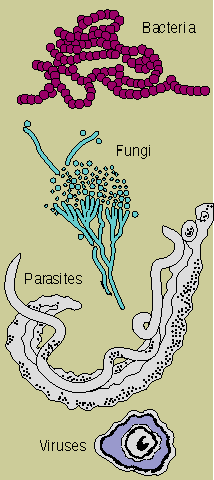 |
The Immune System
The immune system is a bodywide network of cells and organs that
has evolved to defend the body against attacks by "foreign"
invaders.
The proper targets of the immune defenses are infectious
organisms -- bacteria such as these streptococci;
Fungi (this one happens to be the mold from which penicillin is
made);
Parasites, including these worm-like microbes that cause
schistosomiasis; and
Viruses such as this herpes virus. |
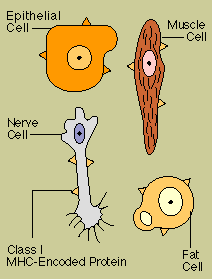 |
Markers of Self
At the heart of the immune response is the ability to distinguish
between self and nonself.
Every body cell carries distinctive molecules that distinguish it
as "self." Normally the body's defenses do not attack tissues that
carry a self marker; rather, immune cells coexist peaceably with
other body cells in a state known as self-tolerance. |
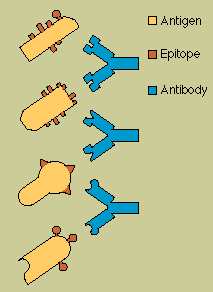 |
Markers of Non-Self
Foreign molecules, too, carry distinctive markers, characteristic
shapes called epitopes that protrude from their surfaces.
One of the remarkable things about the immune system is its
ability to recognize many millions of distinctive non-self
molecules, and to respond by producing molecules such as these
antibodies -- and also cells -- that can match and counteract each
one of the non-self molecules.
Any substance capable of triggering an immune response is known
as an antigen. An antigen can be a bacterium or a virus, or even a
portion or product of one of these organisms. Tissues or cells from
another individual also act as antigens; that's why transplanted
tissues are rejected as foreign. |
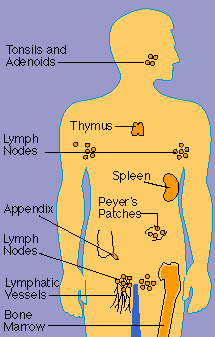 |
Organs of the Immune System
The organs of the immune system are stationed throughout the
body.
They are known as lymphoid organs because they are concerned with
the growth, development, and deployment of lymphocytes -- white
blood cells that are key operatives of the immune system. |
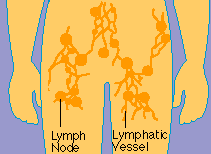 |
Lymphatic System
The organs of the immune system are connected with one another
and with other organs of the body by a network of lymphatic vessels
similar to blood vessels.
Immune cells and foreign particles are conveyed through the
lymphatics in lymph, a clear fluid that bathes the body's tissues.
|
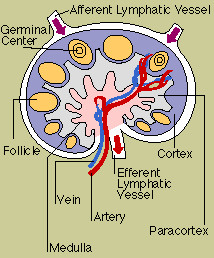 |
Lymph Node
Lymph nodes are small, bean-shaped structures that are laced
throughout the body along the lymphatic routes.
Lymph nodes contain specialized compartments where immune cells
congregate, and where they can encounter antigens. |
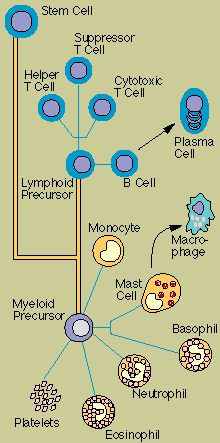 |
Cells of the Immune System
Cells destined to become immune cells, like all blood cells,
arise in the bone marrow from so-called stem cells.
Some develop into myeloid cells, a group typified by the large,
cell- and particle-devouring white blood cells known as phagocytes;
phagocytes include monocytes, macrophages, and neutrophils. Other
myeloid descendants become granule-containing inflammatory cells
such as eosinophils and basophils. Lymphoid precursors develop into
the small white blood cells called lymphocytes. The two major
classes of lymphocytes are B cells and T cells. |
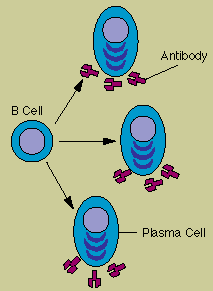 |
B Cells
B cells work chiefly by secreting soluble substances known as
antibodies.
Each B cell is programmed to make one specific antibody. When a B
cell encounters its triggering antigen (along with various accessory
cells), it gives rise to many large plasma cells. Each plasma cell
is essentially a factory for producing that one specific antibody.
|
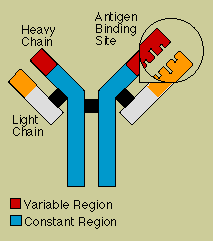 |
Antibody
Each antibody is made up of two identical heavy chains and two
identical light chains, shaped to form a Y.
The sections that make up the tips of the Y's arms vary greatly
from one antibody to another; this is called the variable region. It
is these unique contours in the antigen-binding site that allow the
antibody to recognize a matching antigen, much as a lock matches a
key.
The stem of the Y links the antibody to other participants in the
immune defenses. This area is identical in all antibodies of the
same class -- for instance, all IgEs -- and it's called the constant
region. |
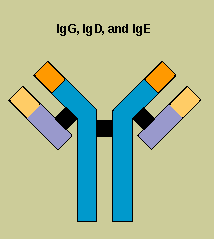 |
IgG, IgD, and IgE
Antibodies belong to a family of large protein molecules known as
immunoglobulins.
Scientists have identified nine chemically distinct classes of
human immunoglobulins, four kinds of IgG and two kinds of IgA, plus
IgM, IgE, and IgD.
Immunoglobulins G, D, and E are similar in appearance. IgG, the
major immunoglobulin in the blood, is also able to enter tissue
spaces; it works efficiently to coat microorganisms, speeding their
uptake by other cells in the immune system. IgD is almost
exclusively found inserted into the membrane of B cells, where it
somehow regulates the cell's activation. IgE is normally present in
only trace amounts, but it is responsible for the symptoms of
allergy. |
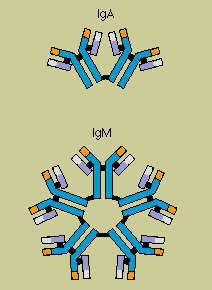 |
IgA and IgM
IgA -- a doublet -- concentrates in body fluids such as tears,
saliva, and the secretions of the respiratory and gastrointestinal
tracts.
It is, thus, in a position to guard the entrances to the body.
IgM usually combines in star-shaped clusters. It tends to remain
in the bloodstream, where it is very effective in killing bacteria.
|
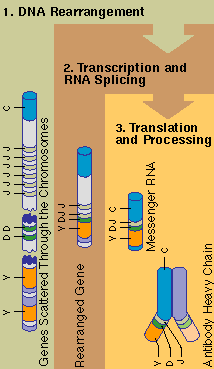 |
Antibody Genes
Scientists long wondered how all the genetic information needed
to make millions of different antibodies could fit in a limited
number of genes.
The answer is that antibody genes are pieced together from widely
scattered bits of DNA, and the possible combinations are nearly
endless. As this gene forms, it assembles segments that will
determine the variable-V, diversity-D, joining-J, and constant-C
segments of this antibody molecule, a typical IgM heavy chain.
|
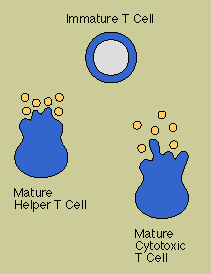 |
T Cells
T cells contribute to the immune defenses in two major ways. Some
help regulate the complex workings of the immune system, while
others are cytotoxic and directly contact infected cells and destroy
them.
Chief among the regulatory T cells are "helper/inducer" T cells.
They are needed to activate many immune cells, including B cells and
other T cells. Another subset of regulatory T cells acts to turn off
or suppress immune cells.
Cytotoxic T cells help rid the body of cells that have been
infected by viruses as well as cells that have been transformed by
cancer. They are also responsible for the rejection of tissue and
organ grafts. |
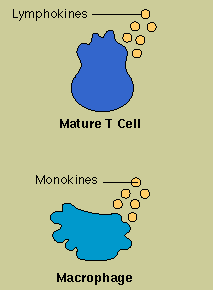 |
Cytokines
Cytokines are diverse and potent chemical messengers secreted by
the cells of the immune system -- and the chief tool of T cells.
Lymphocytes, including both T cells and B cells, secrete
lymphokines, while monocytes and macrophages secrete monokines.
Binding to specific receptors on target cells, cytokines recruit
many other cells and substances to the field of action. Cytokines
encourage cell growth, promote cell activation, direct cellular
traffic, and destroy target cells -- including cancer cells. Because
they serve as a messenger between white cells, or leukocytes, many
cytokines are also known as interleukins. |
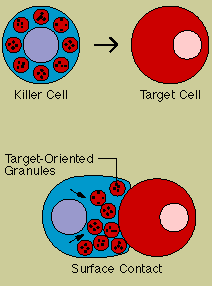 |
Natural Killer Cells
At least two types of lymphocytes are killer cells -- cytotoxic T
cells and natural killer cells.
To attack, cytotoxic T cells need to recognize a specific
antigen, whereas natural killer or NK cells do not. Both types
contain granules filled with potent chemicals, and both types kill
on contact. The killer binds to its target, aims its weapons, and
delivers a burst of lethal chemicals. |
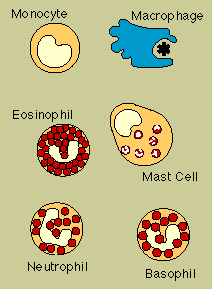 |
Phagocytes and Granulocytes
Phagocytes are large white cells that can engulf and digest
foreign invaders.
They include monocytes, which circulate in the blood, and
macrophages, which are found in tissues throughout the body, as well
as neutrophils, cells that circulate in the blood but move into
tissues where they are needed. Macrophages are versatile cells; they
act as scavengers, they secrete a wide variety of powerful
chemicals, and they play an essential role in activating T cells.
Neutrophils are not only phagocytes but also granulocytes: they
contain granules filled with potent chemicals. These chemicals, in
addition to destroying microorganisms, play a key role in acute
inflammatory reactions. Other types of granulocytes are eosinophils
and basophils. Mast cells are granule-containing cells in tissue.
|
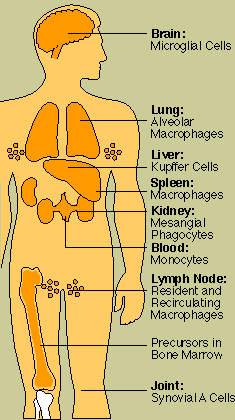 |
Phagocytes in the Body
Specialized phagocytes are found in organs throughout the body.
|
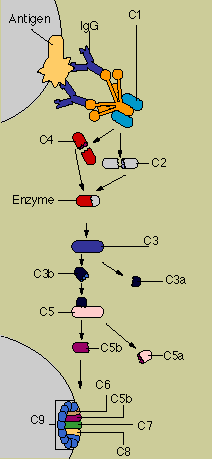 |
Complement
The complement system consists of a series of proteins that work
to "complement" the work of antibodies in destroying bacteria.
Complement proteins circulate in the blood in an inactive form.
The so-called "complement cascade" is set off when the first
complement molecule, C1, encounters antibody bound to antigen in an
antigen-antibody complex. Each of the complement proteins performs
its specialized job in turn, acting on the molecule next in line.
The end product is a cylinder that punctures the cell membrane and,
by allowing fluids and molecules to flow in and out, dooms the
target cell. |
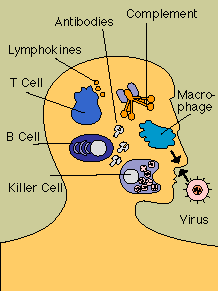 |
Mounting an Immune Response
Microbes attempting to get into the body must first get past the
skin and mucous membranes, which not only pose a physical barrier
but are rich in scavenger cells and IgA antibodies.
Next, they must elude a series of nonspecific defenses -- cells
and substances that attack all invaders regardless of the epitopes
they carry. These include patrolling scavenger cells, complement,
and various other enzymes and chemicals.
Infectious agents that get past the nonspecific barriers must
confront specific weapons tailored just for them. These include both
antibodies and cells. Almost all antigens trigger both nonspecific
and specific responses. |
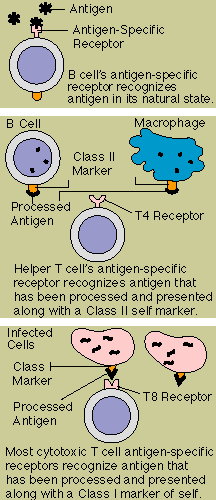 |
Antigen Receptors
Both B cells and T cells carry customized receptor molecules that
allow them to recognize and respond to their specific targets.
The B cell's antigen-specific receptor is a sample of the
antibody it is prepared to manufacture; it recognizes antigen in its
natural state.
The T cell receptor system is more complex. A T cell can
recognize an antigen only after the antigen is processed and
presented to it by a so-called antigen-presenting cell, in
combination with a special type of cell marker.
The T4 T cell's receptor looks for an antigen that has been
broken down by an immune system cell such as a macrophage or a B
cell and combined with a marker, known as a class II protein,
carried by immune cells. The T8 T cell's receptor recognizes an
antigen fragment produced within the cell, combined with a class I
protein; class I proteins are found on virtually all body cells.
This complicated arrangement assures that T cells act only on
precise targets and at close range. |
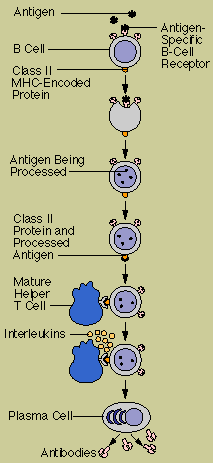 |
Activation of B Cells to Make Antibody
The B cell uses its receptor to bind a matching antigen, which it
proceeds to engulf and process.
Then it combines a fragment of antigen with its special marker,
the class II protein. This combination of antigen and marker is
recognized and bound by a T cell carrying a matching receptor. The
binding activates the T cell, which then releases lymphokines --
interleukins -- that transform the B cell into an antibody-secreting
plasma cell. |
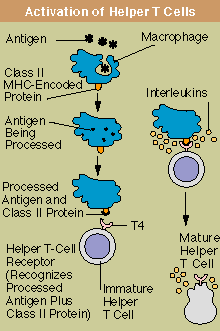 |
Activation of T Cells: Helper and Cytotoxic
After an antigen-presenting cell such as a macrophage has
ingested and processed an antigen, it presents the antigen fragment,
along with a class II marker protein, to a matching helper T cell
with a T4 receptor.
The binding prompts the macrophage to release interleukins that
allow the T cell to mature.
A cytotoxic T cell recognizes antigens such as virus
proteins,which are produced within a cell, in combination with a
class I self-marker protein. With the cooperation of a helper T
cell, the cytotoxic T cell matures. Then, when the mature cytotoxic
T cell encounters its specific target antigen combined with a class
I marker protein -- for instance, on a body cell that has been
infected with a virus -- it is ready to attack and kill the target
cell.
|
 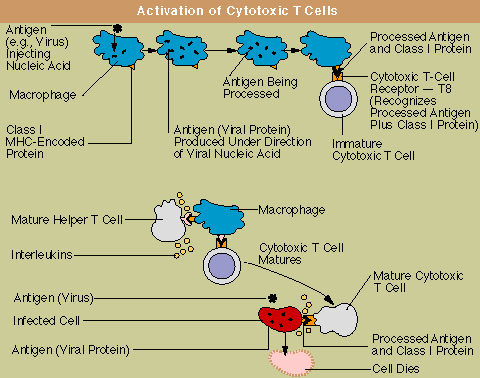
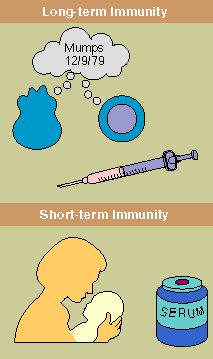 |
Immunity: Short- and Long-Term Cell Memory
Whenever T cells and B cells are activated, some become "memory"
cells.
The next time that an individual encounters that same antigen,
the immune system is primed to destroy it quickly. Long-term
immunity can be stimulated not only by infection but also by
vaccines made from infectious agents that have been inactivated or,
more commonly, from minute portions of the microbe.
Short-term immunity can be transferred passively from one
individual to another via antibody-containing serum; similarly,
infants are protected by antibodies they receive from their mothers
(primarily before birth). |
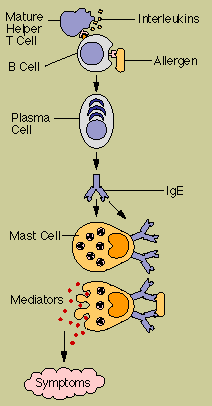 |
Disorders of the Immune System: Allergy
When the immune system malfunctions, it can unleash a torrent of
disorders and diseases.
One of the most familiar is allergy. Allergies such as hay fever
and hives are related to the antibody known as IgE. The first time
an allergy-prone person is exposed to an allergen -- for instance,
grass pollen -- the individual's B cells make large amounts of grass
pollen IgE antibody. These IgE molecules attach to
granule-containing cells known as mast cells, which are plentiful in
the lungs, skin, tongue, and linings of the nose and
gastrointestinal tract. The next time that person encounters grass
pollen, the IgE-primed mast cell releases powerful chemicals that
cause the wheezing, sneezing, and other symptoms of allergy.
|
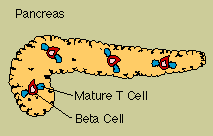 |
Disorders of the Immune System: Autoimmune Disease
Sometimes the immune system's recognition apparatus breaks down,
and the body begins to manufacture antibodies and T cells directed
against the body's own cells and organs.
Such cells and autoantibodies, as they are known, contribute to
many diseases. For instance, T cells that attack pancreas cells
contribute to diabetes, while an autoantibody known as rheumatoid
factor is common in persons with rheumatoid arthritis. |
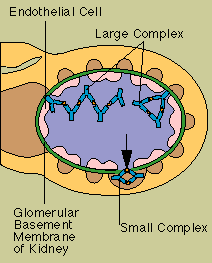 |
Disorders of the Immune System: Immune Complex Disease
Immune complexes are clusters of interlocking antigens and
antibodies.
Normally they are rapidly removed from the bloodstream. In some
circumstances, however, they continue to circulate, and eventually
they become trapped in and damage the tissues of the kidneys, as
seen here, or in the lungs, skin, joints, or blood vessels.
|
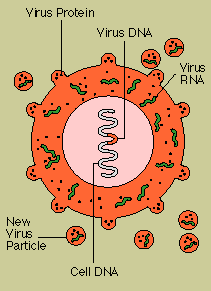 |
Disorders of the Immune System: AIDS
When the immune system is lacking one or more of its components,
the result is an immunodeficiency disorder.
These can be inherited, acquired through infection, or produced
as an inadvertent side effect of drugs such as those used to treat
cancer or transplant patients.
AIDS is an immunodeficiency disorder caused by a virus that
destroys helper T cells and that is harbored in macrophages as well
as helper (T4) T cells. The AIDS virus splices its DNA into the DNA
of the cell it infects; the cell is thereafter directed to churn out
new viruses. |
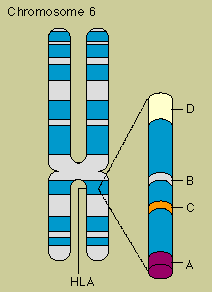 |
Human Tissue Typing for Organ Transplants
For an organ transplant to "take," it is necessary to minimize
the body's drive to rid itself of foreign tissue.
One way is to make sure that the markers of self on the donor's
tissue are as similar as possible to those of the recipient. Because
tissue typing is usually done on white blood cells, or leukocytes,
the markers are referred to as human leukocyte antigens, or HLA.
Each cell has a double set of six major antigens, HLA-A, B, and C,
and three types of HLA-D. Since each of the antigens exists, in
different individuals, in as many as 20 varieties, the number of
possible HLA types is about 10,000. The genes that encode the HLA
antigens, located on chromosome 6, are the subject of intense
research. |
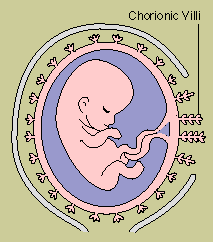 |
"Privileged" Immunity
A child in the womb carries foreign antigens from the father as
well as immunologically compatible self antigens from the mother.
One might expect this condition to trigger a graft rejection, but
it does not because the uterus is an "immunologically privileged"
site where immune responses are subdued. |
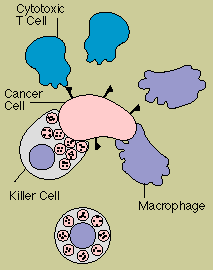 |
Immunity and Cancer
When normal cells turn into cancer cells, some of the antigens on
their surface change.
These new or altered antigens flag immune defenders, including
cytotoxic T cells, natural killer cells, and macrophages. According
to one theory, patrolling cells of the immune system provide
continuing bodywide surveillance, spying out and eliminating cells
that undergo malignant transformation. Tumors develop when the
surveillance system breaks down or is overwhelmed. |
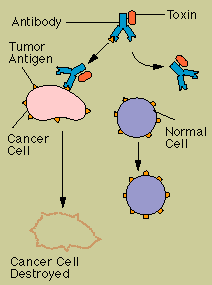 |
Immunotherapy
A new approach to cancer therapy uses antibodies that have been
specially made to recognize specific cancer.
When coupled with natural toxins, drugs, or radioactive
substances, the antibodies seek out their target cancer cells and
deliver their lethal load. Alternatively, toxins can be linked to a
lymphokine and routed to cells equipped with receptors for the
lymphokine. |
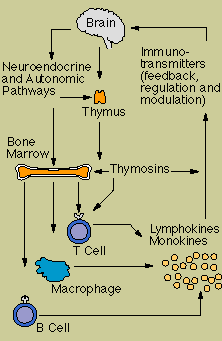 |
The Immune System and the Nervous System
Biological links between the immune system and the central
nervous system exist at several levels.
Hormones and other chemicals such as neuropeptides, which convey
messages among nerve cells, have been found also to "speak" to cells
of the immune system -- and some immune cells even manufacture
typical neuropeptides. In addition, networks of nerve fibers have
been found to connect directly to the lymphoid organs.
The picture that is emerging is of closely interlocked systems
facilitating a two-way flow of information. Immune cells, it has
been suggested, may function in a sensory capacity, detecting the
arrival of foreign invaders and relaying chemical signals to alert
the brain. The brain, for its part, may send signals that guide the
traffic of cells through the lymphoid organs. |
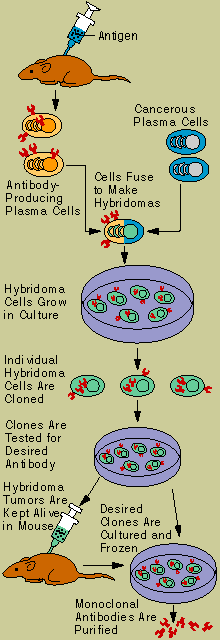 |
Hybridoma Technology
Thanks to a technique known as hybridoma technology, scientists
are now able to make quantities of specific antibodies.
A hybridoma can be produced by injecting a specific antigen into
a mouse, collecting antibody-producing cells from the mouse's
spleen, and fusing them with long-lived cancerous immune cells.
Individual hybridoma cells are cloned and tested to find those that
produce the desired antibody. Their many identical daughter clones
will secrete, over a long period of time, the made-to-order
"monoclonal" antibody. |
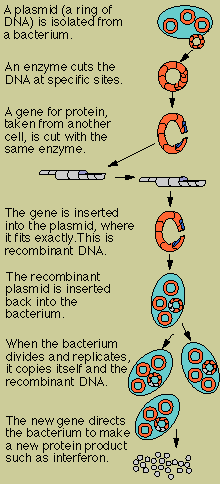 |
Genetic Engineering
Genetic engineering allows scientists to pluck genes -- segments
of DNA -- from one type of organism and combine them with genes of a
second organism.
In this way relatively simple organisms such as bacteria or yeast
can be induced to make quantities of human proteins, including
interferons and interleukins. They can also manufacture proteins
from infectious agents such as the hepatitis virus or the AIDS
virus, for use in vaccines. |
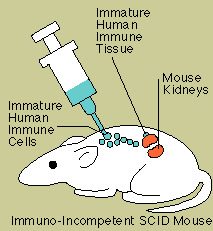 |
The SCID-hu Mouse
The SCID mouse, which lacks a functioning immune system of its
own, is helpless to fight infection or reject transplanted tissue.
By transplanting immature human immune tissues and/or immune
cells into these mice, scientists have created an in vivo model that
promises to be of immense value in advancing our understanding of
the immune system. | |